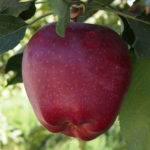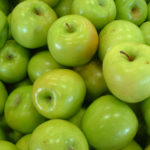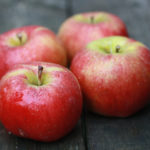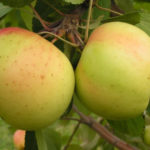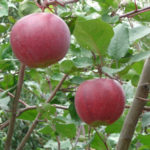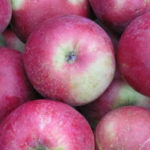Honey Crisp apple variety
I don't want to once again quote and duplicate various sources that publish information about the American apple variety Honey Crisp, or Honeycrisp, but this variety is really the most popular in America, Canada and Europe at the moment. Attempts are being made, very successful, to grow the popular novelty in New Zealand and Australia. The variety is well known in Russia, Belarus and Ukraine. True, an overseas guest appeared in our area relatively recently, in the early 2000s. This culture has combined the most popular characteristics, so the interest of gardeners in it is unusually great. According to forecasts of the American Apple Association (US Apple Association), by 2020, the variety will take the third place in cultivation in America. And at the moment it is in the top of the most popular apples among consumers.
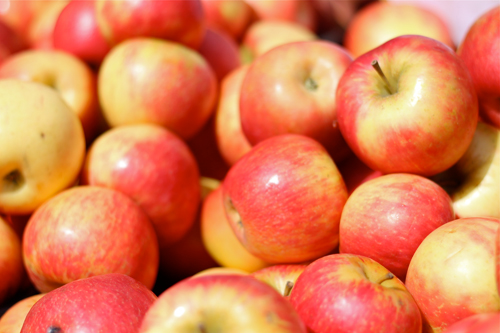
History of creation
American breeders from the Center for Horticultural Research at the University of Minnesota developed this variety back in 1960, starting to create a new product, scientists set themselves the task of creating a variety that is resistant to the harsh winter conditions of Minnesota. Initially, it was believed that the parental forms were Honeygold, obtained in 1930 from crossing Golden Delicious and Kharalson) and Mekaun (Macoun). But subsequently (in 2004) DNA analysis refuted these claims. From now on, the parents of Honey Crisp are considered to be Keepsake and another, unknown variety (code name MN 1627). But by the great-grandmothers of the apple tree MN 1627, further research identified the same Golden Delicious and the Duchess of Oldenburg, or Duchess of Oldenburg (which we simply call Borovinka and belongs to folk selection, has been known since the end of the 18th century). Well, how can you not remember Santa Barbara! Honey Crisp appeared in the open spaces of the commercial market in early 1990 and immediately declared itself quite loudly. Many call it a club variety.
In recent years, in America, as well as throughout the world, it has become fashionable to look for traces of GMOs in all commercially successful fruits and vegetables. This question did not pass by our hero either. But, as scientists have proved, it has nothing to do with GMOs, but is a solid hybrid obtained by natural pollination.
By what names is our hero known?
The most common name for the variety is Honeycrisp, or Honey Crisp, which translates as honey crunch or honey freshness. This is what the apple tree is called in the USA. For the European Union, the novelty was patented as Honey Crunch, or Honey Crunch. In the State Register of Breeding Achievements of Russia, our hero was registered in 2017 as Honeikrisp. Applicant and originator of Sady Belogorya LLC. The admission region is the Central Black Earth District. And in Belarus, the name was changed to Arnabel. It is under this name that the crop was included in the National Register of Varieties for Cultivation in Belarus in 2014.
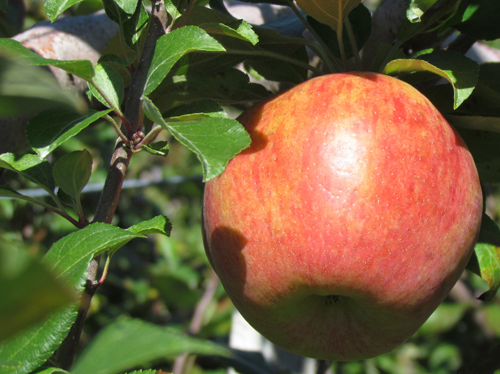
Description
According to the description of the State Register, the plant is medium-growing, other sources describe it as fast-growing. The tree is medium-sized, according to some information its height reaches 3 - 4 m. The crown is narrow oval, medium thickened. Skeletal branches are straight-growing, short, of medium strength, branch off from the trunk at an angle close to a straight line, and are compactly located. The ends of the shoots are directed upwards. The shoots are pubescent, the bark is light brown, with a greenish tint. Lentils are light, round, convex, numerous. Shoot-forming ability is average. Leaves are medium in size, green, ovate-elongated, the apex is long-pointed, the base is rounded, the jagged edges are obtusely serrate. The surface of the leaf blade is smooth, shiny, the nerve is rough. The petiole is ordinary, uncolored. Stipules subulate. The type of fruiting is mixed.
The fruits are large or very large, beautiful, bright. According to the State Register, the mass is 170 g, according to other sources - 180 - 260 g.Fruits are one-dimensional, rounded-conical, slightly elongated, regular in shape, sometimes slightly asymmetrical. The surface is smooth, slightly ribbed. The funnel is blunt-conical, of medium depth and width, without traces of rustiness. The saucer is deep, of medium width and depth. The calyx is closed, sometimes half-open. The seed chambers are small, closed. The peduncle is rather short, but not thick, erect. The skin is not thick, smooth, shiny, covered with a waxy coating of low intensity. The main color is greenish-yellow, the integumentary color takes up most of the fruit in the form of an orange-red blush with red strokes. There are many subcutaneous points, but due to their small size and grayish color, they are not very striking. The pulp is of a pleasant creamy color or light yellow, dense, prickly, fine-grained consistency, tender and very juicy, slightly aromatic. Many people note that when biting an apple, a pleasant characteristic crunch is heard, which is the hallmark of the variety. The taste is sweet and sour, very harmonious, rich and refreshing. Assessment of tasters from 4.5 (State Register) to 5.0 (other sources) points. There is information that sourness is more manifested in the taste in cool regions, but this does not make the taste worse.
If you lay out the inner content of the fruit on the shelves, then 100 g of pulp accumulates: dry matter 13.8%, sugar 14.9%, vitamin C 2.3 mg. In addition, the pulp contains: vitamin A, calcium, iron, potassium, boron. On average, one Honey Crisp apple contains about 80 calories.
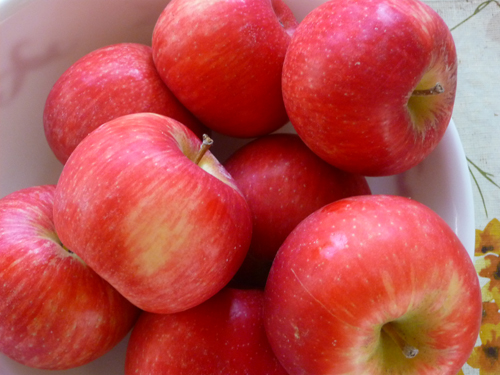
Characteristics
- The excellent early maturity of the Honeycrisp apple tree allows impatient gardeners to get a real harvest already for 2 or 3 years (however, on the 54-118 rootstock it begins to bear fruit only in the 4th year). But the first flowering can begin in the spring after planting. Experienced gardeners recommend removing the color so that the plant will put all its strength into development;
- flowering takes place in medium terms. Our hero blooms for a rather long period. According to some testimonies, recurrent frosts are not terrible for flowers;
- in terms of ripening, the State Register classifies the variety as winter species. Removable ripeness begins at the end of September, but under favorable weather conditions, harvesting will be possible around the middle of the month. The consumption period starts at the beginning of November, as the apples have to mature;
- the harvest is harvested in several passes, since the fruits ripen at different times. If for some reason the harvest does not have time to be harvested, there is no need to worry, ripe fruits are well attached to the branches. But shedding does happen sometimes. The reason, oddly enough, is in good knotting. In one inflorescence, 3 or 4 fruits can be set. Due to the short stalk and large size, the developing apples become cramped, and they begin to push out the neighboring fruit;
- the yield is declared high. This is confirmed by the use of the variety for laying industrial gardens. By the age of four or five, the tree already yields about 10.0 kg of selected apples. The yield only increases every year. According to the State Register, the average yield per hectare is 99.9 centners;
- since the main requirement for the created variety was sufficient frost resistance, then our hero has everything in order with this indicator. The tree perfectly withstands a drop in winter temperatures to minus 30 ° C, there is evidence that even at minus 35 ° C the apple tree does not experience problems and comes out of wintering well. The State Register estimates this indicator as average, while gardeners, on the contrary, praise it for good resistance to low temperatures. Some sources cite reviews of gardeners from Ufa and Mordovia, where Honey Crisp normally develops and bears fruit. Also at the Michurinsky Institute experiments were carried out on the artificial freezing of culture. The apple tree withstood temperatures down to minus 40 ° C. With a further decrease, the crust was severely damaged, but the cambium remained alive;
- drought resistance and heat resistance according to the State Register is also estimated at an average level;
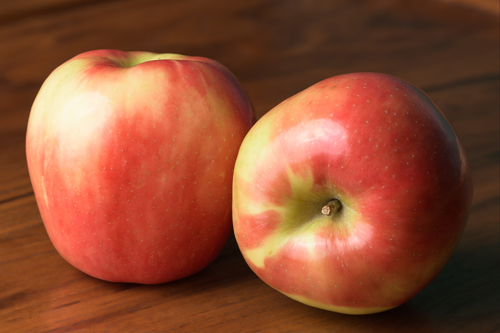
- immunity is not bad, but it cannot be called excellent. The variety is resistant to scab.But powdery mildew can get sick, especially the ends of young shoots are often affected. In addition, apples suffer greatly from bitter pitting, which affects the fruit already in the process of ripening. The big disadvantage of Honeycrisp is that during the formation of the crop, the plant will have to be treated with calcium preparations at least 10 times in order for the fruits to ripen healthy;
- of the pests, the moth can bring the greatest damage;
- problems with transportability can also arise, since dents can form on the surface of the fruit during transportation, which shorten the shelf life. Therefore, the crop should not be moved in bulk, but each apple should be packed separately;
- but in terms of keeping quality, our hero is a real champion. The harvest will stay in special storage facilities for 6 - 7 months. At the same time, its juicy pulp does not soften, both crunchiness and taste are fully preserved;
- the method of consumption is primarily in natural form. The harmonious taste and crunchy flesh make the fruit an excellent dessert that can be paired with cheese, nuts and even vegetables such as cabbage or daikon. If desired, you can make jam, jam, fruit puree, filling for baking from apples.
Pollinators
Honey Crisp is a self-fertile apple tree. Without a good pollinator that blooms at the same time as our hero, it will not be possible to get a decent harvest. Suitable neighbors who are able to have a beneficial effect on the formation of a large-fruited crop are: Idared, Golden Delicious, Askold, Everest.
Agrotechnics
Planting the Honey Crisp apple tree can be carried out in spring and autumn, however, spring planting, especially in a warm region, will require more frequent watering. The most suitable stock is M9. In order for the apples to pick up more sugar, the crown should be as illuminated as possible, so choose a well-lit area, protected from the wind from the north side. Such a cozy corner will be more often visited by pollinating insects, which is an undoubted advantage for our variety. Soils are suitable for highly structured, fertile, for example, chernozem, loam. Sandy loam is also suitable, but on it the plant will need to increase the dose of fertilizers applied and provide regular watering. Usually, watering is carried out as needed, taking into account natural precipitation. Ideally, the soil in the trunk circle should be moderately moist. During feeding, you should not get carried away with nitrogen-containing fertilizers - in large quantities or at the wrong time, they can cause shedding of fruits. A mandatory technique that allows you to form a large-fruited crop is rationing, which is carried out at the stage of natural shedding of the ovary. If you do not carry out this procedure, then the strength of the apple tree is gradually depleted, which can lead to periodicity in fruiting. The rest of the culture care is no different from the usual.
The beautiful apple tree Honey Crisp, despite the fact that it belongs to the club varieties, quickly spread throughout the countries in which the crop is grown. She also did not pass by Russia, where she became a real sensation. After all, rare domestic apple trees can compete with an American woman regarding taste and storage duration. The frost resistance of the variety allows it to be cultivated even in cool regions, as evidenced by gardeners. Another attractive quality is early maturity, however, the rootstock influences the speed of entry into fruiting. The need for prophylactic treatments and calcium supplements complicates the care of the plant somewhat. In addition, a prerequisite for high productivity is crop rationing. But, despite these shortcomings, our hero is considered one of the leading varieties in the world, and very promising for Russia, especially for regions with a temperate and warm climate.
